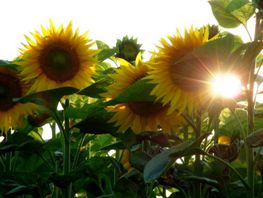Lifestyle variations
The
sunflower is adapted to a wide range of soil types
 including coarse,
medium, and fine textured soils, as well as climatic conditions,
including a medium drought tolerance.
However it produces the most when grown on land that has a high
water holding capacity, good internal drainage, and high fertility.
The active growth period is during summer; however it has a
relatively short lifespan which last approximately the
length of the summer
growing season.
including coarse,
medium, and fine textured soils, as well as climatic conditions,
including a medium drought tolerance.
However it produces the most when grown on land that has a high
water holding capacity, good internal drainage, and high fertility.
The active growth period is during summer; however it has a
relatively short lifespan which last approximately the
length of the summer
growing season.
The sunflower is intolerant to shade exposure and needs full sun exposure. It has adapted to this necessity by having a heliotropic head which rotates to follow the sun, hence the name sunflower. The heads of the sunflower are heliotropic, meaning movement of the head in response to the direction of the sun. As the sun rises they turn to face the east and slowly follow the sun across the sky ending in the west. Then they turn back to the east to prepare for the next day. Other movements within the sunflower includes excessive primary growth and some secondary growth.
 The
sunflower searches for light and can be seen constantly moving to find
the best light, this movement can be captured by time-lapse photography,
the initial growth of a sunflower can be viewed at this clip of a
Sunflower Time-Lapse.
The
sunflower searches for light and can be seen constantly moving to find
the best light, this movement can be captured by time-lapse photography,
the initial growth of a sunflower can be viewed at this clip of a
Sunflower Time-Lapse.
The sunflower is an annual plant with an erect stem and broad, phototrophic leaves, also present is a tap root as well as lateral surface roots. The stem of the sunflower has bristles, these are to prevent water loss as well as deter animal predation. The leaves are oppositely positioned leaves and broad to absorb sunlight for photosynthesis.
Although the name implies that it is a single flower, it actually consists of thousands of tiny flowers that are bound to a common receptacle. This is referred to as an inflorscences because there is an arrangement of flowers in a cluster. The thousands of tiny flowers are known as florets and have no petals. Whereas the flowers which are strewn about the circumference of the head are the ray flowers, similar to the suns rays.
To discover further details about the petals parts of a sunflower visit Flower Structure.
Finally to see a sunflower opening it's ray petals and searching for light over an 8 hour period see this Sunflower Opening Time-Lapse.
